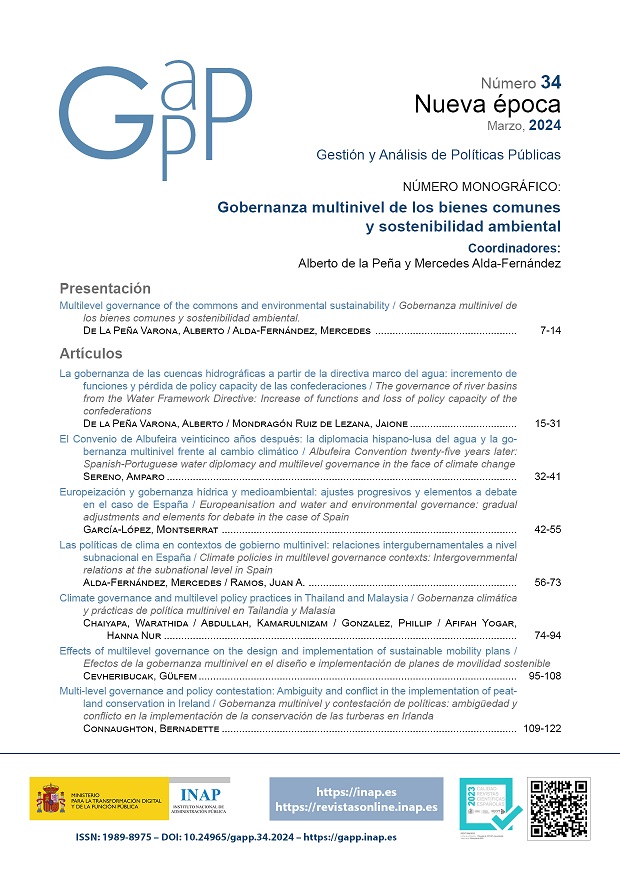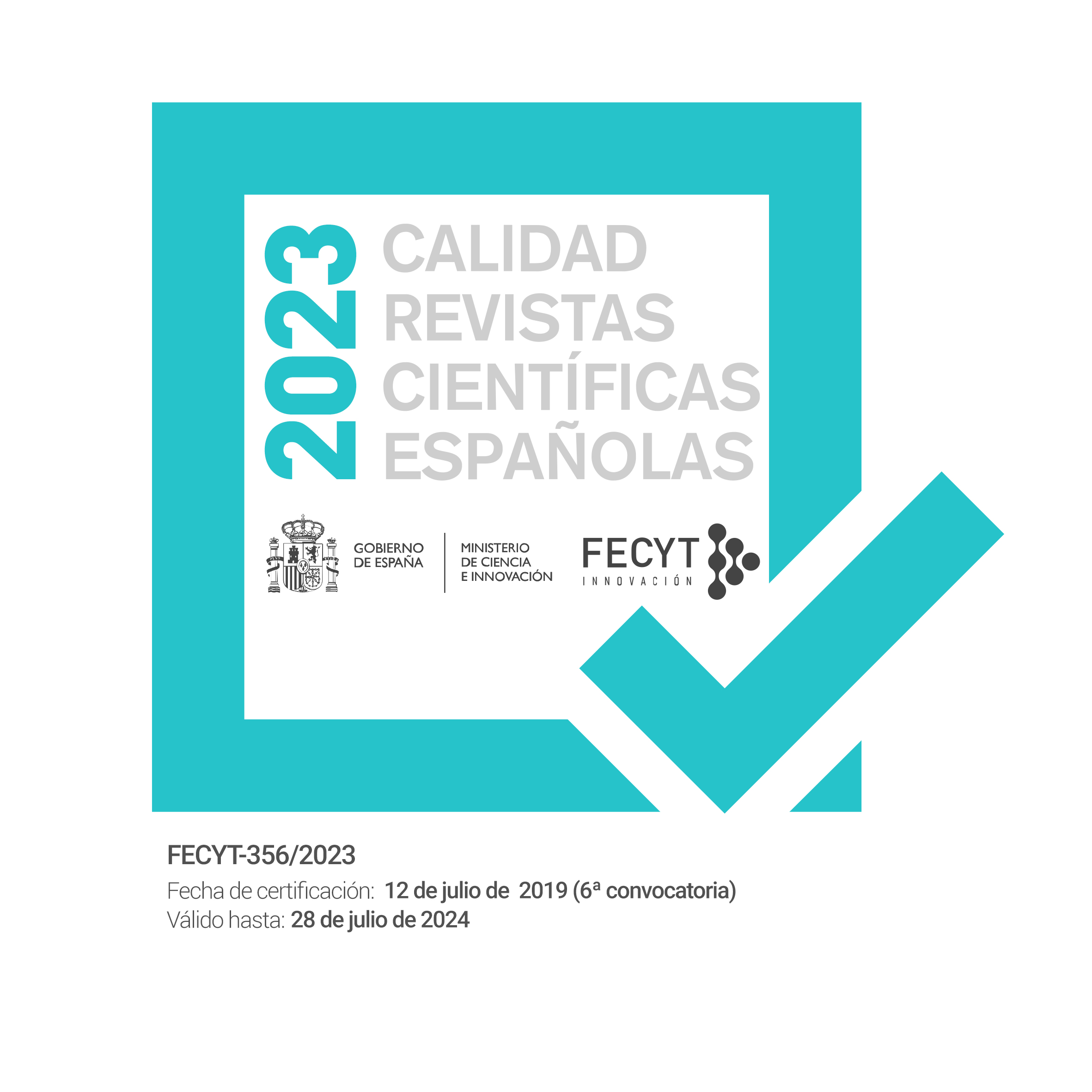Effects of multilevel governance on the design and implementation of sustainable mobility plans
DOI:
https://doi.org/10.24965/gapp.11264Palabras clave:
gobierno multinivel, transiciones sostenibles, gobierno subnacional, movilidad urbana sostenibleResumen
Objetivos: la naturaleza policéntrica de las estructuras de gobernanza multinivel con múltiples actores que interactúan en diferentes niveles puede facilitar las transiciones sostenibles. Este estudio tiene como objetivo explorar el impacto de la gobernanza multinivel en el diseño y la implementación de planes de movilidad urbana sostenible dentro de la estructura gubernamental de dos niveles de Suecia. Metodología: el estudio se basa en una revisión cualitativa de la literatura académica, fuentes secundarias que incluyen una revisión de documentos de políticas nacionales y conocimientos empíricos extraídos del estudio de caso de Umeå, una ciudad sueca de tamaño mediano que participa en varios programas nacionales, locales e iniciativas transnacionales para acelerar las transiciones hacia la sostenibilidad. Los datos empíricos se recopilan a través de entrevistas semiestructuradas con expertos en políticas, formuladores de políticas, transporte y planificadores urbanos que son responsables de la formulación e implementación de políticas de transporte dentro de las instituciones nacionales y locales. Resultados: la gobernanza multinivel de las políticas de transporte y movilidad urbana sostenible en Suecia produce varios efectos positivos para el diseño y la implementación de políticas. Estos incluyen una clara división de responsabilidades entre las autoridades públicas a nivel de gobierno nacional, regional y local, lo que ayuda a superar problemas como la falta de rendición de cuentas y responsabilidad. Conclusiones: la gobernanza multinivel de las políticas de movilidad urbana sostenible en Suecia permite a las autoridades locales tener acceso a recursos adicionales e intercambio de conocimientos a través de redes compuestas por varios actores públicos y privados.
Descargas
Citas
Åkerman, J. and Höjer, M. (2006). How much transport can the climate stand? - Sweden is on a sustainable path in 2050. Energy Policy, 34(14), 1944-1957. https://doi.org/10.1016/j.enpol.2005.02.009
Antonson, H., Isaksson, K., Storbjörk, S. and Hjerpe, M. (2016). Negotiating climate change responses: Regional and local perspectives on transport and coastal zone planning in South Sweden. Land Use Policy, (52), 297-305. https://doi.org/10.1016/j.landusepol.2015.12.033
Bache, I., Bartle, I., Flinders, M. and Marsden, G. (2015). Blame Games and Climate Change: Accountability, Multi-Level Governance and Carbon Management. The British Journal of Politics and International Relations, 17(1), 64-88. https://doi.org/10.1111/1467-856x.12040
Baldersheim, H. and Ståhlberg, K. (2002). From Guided Democracy to Multi-Level Governance: Trends in Central-Local Relations in the Nordic Countries. Local Government Studies, 28(3), 74-90. https://doi.org/10.1080/714004149
Benz, A. (2021). Policy Change and Innovation in Multilevel Governance. Edward Elgar Publishing.
Brůhová Foltýnová, H., Vejchodská, E., Rybová, K. and Květoň, V. (2020). Sustainable urban mobility: One definition, different stakeholders’ opinions. Transportation Research Part D: Transport and Environment, (87), 1-14. https://doi.org/10.1016/j.trd.2020.102465
Bulkeley, H. (2010). Cities and the Governing of Climate Change. Annual Review of Environment and Resources, 35(1), 229-253. https://doi.org/10.1146/annurev-environ-072809-101747
De Mello, L. and Jalles, J. T. (2022). Decentralisation and the environment: Survey-based and cross-country evidence [REM Working Paper 0215-2022]. ISEG - Lisbon School of Economics and Management, REM, Universidade de Lisboa. https://rem.rc.iseg.ulisboa.pt/wps/pdf/REM_WP_0215_2022.pdf
Ebinger, F. and Richter, P. (2016). Decentralizing for performance? A quantitative assessment of functional reforms in the German Länder. International Review of Administrative Sciences, 82(2), 291-314. https://doi.org/10.1177/0020852315586916
Elander, I. and Montin, S. (1990). Decentralisation and control: central-local government relations in Sweden. Policy and Politics, 18(3), 165-180.
European Commission, Directorate-General for Regional and Urban Policy Ladner, A., Keuffer, N. and Baldersheim, H. (2016). Self-rule index for local authorities (release 1.0): final report. Publications Office of the European Union. https://data.europa.eu/doi/10.2776/432291
Feltenius, D. (2015). Multi-Level governance as ‘Post-Constitutional’ politics: subnational actors and the Swedish Constitution. Local Government Studies, 41(2), 301-319. https://doi.org/10.1080/03003930.2014.919267
Fenton, P. (2017). National infrastructure, small towns, and sustainable mobility – experiences from policy and strategy in two Swedish municipalities. Journal of Environmental Planning and Management, 60(9), 1660–1682. https://doi.org/10.1080/09640568.2016.1246998
Fenton, P. and Gustafsson, S. (2015). Contesting sustainability in urban transport - perspectives from a Swedish town. Natural Resources Forum, 39(1), 15–26. https://doi.org/10.1111/1477-8947.12061
Fuhr, H., Hickmann, T. and Kern, K. (2018). The role of cities in multi-level climate governance: local climate policies and the 1.5 °C target. Current Opinion in Environmental Sustainability, (30), 1-6. https://doi.org/10.1016/j.cosust.2017.10.006
Hooghe, L. (1995). Subnational mobilisation in the European union. West European Politics, 18(3), 175-198. https://doi.org/10.1080/01402389508425097
Hooghe, L. and Marks, G. (2009). Does Efficiency Shape the Territorial Structure of Government? Annual Review of Political Science, 12(1), 225-241. https://doi.org/10.1146/annurev.polisci.12.041107.102315
Hudson, C. (1993). Against all odds: local economic development policies and local government autonomy in Sweden and Britain [PhD dissertation]. Umeå universitet. https://urn.kb.se/resolve?urn=urn:nbn:se:umu:diva-66109
Hysing, E., Frändberg, L. and Vilhelmson, B. (2014). Compromising sustainable mobility? The case of the Gothenburg congestion tax. Journal of Environmental Planning and Management, 58(6), 1058-1075. https://doi.org/10.1080/09640568.2014.912615
Johansson, F., Tornberg, P. and Fernström, A. (2018). A function-oriented approach to transport planning in Sweden: Limits and possibilities from a policy perspective. Transport Policy, (63), 30-38. https://doi.org/10.1016/j.tranpol.2017.11.006
Jordan, A., Huitema, D., Schoenefeld, J., Van Asselt, H. and Forster, J. (2018). Governing Climate Change Polycentrically: Setting the Scene. In A. Jordan, D. Huitema, H. Van Asselt and J. Forster (eds.), Governing Climate Change: Polycentricity in Action? (pp. 3-26). Cambridge University Press. https://doi.org/10.1017/9781108284646.002
Joss, S. (2015). Sustainability and the City? In Sustainable Cities: Governing for Urban Innovation (2.ª ed., pp. 1-43). Palgrave Macmillan.
Kern, K. (2019). Cities as leaders in EU multilevel climate governance: embedded upscaling of local experiments in Europe. Environmental Politics, 28(1), 125-145. https://doi.org/10.1080/09644016.2019.1521979
Köhler, J., Whitmarsh, L., Nykvist, B., Schilperoord, M., Bergman, N. and Haxeltine, A. (2009). A transitions model for sustainable mobility. Ecological Economics, 68(12), 2985-2995. https://doi.org/10.1016/j.ecolecon.2009.06.027
Kristianssen, A. C. and Granberg, M. (2021). Transforming Local Climate Adaptation Organization: Barriers and Progress in 13 Swedish Municipalities. Climate, 9(4), article 52. https://doi.org/10.3390/cli9040052
Kyriakopoulou, E., Lu, T. and Hart, R. (2021). Towards zero emissions from Swedish urban transport [Report 7004 from the project ‘To buy or not to buy’]. Swedish Environmental Protection Agency. https://www.naturvardsverket.se/publikationer/7000/towards-zero-emissions-from-swedish-urban-transport/
Litman, T. (2023). Well measured: Developing Indicators for Sustainable and Livable Transport Planning. Victoria Transport Policy Institute. https://www.vtpi.org/wellmeas.pdf
Loo, B. P. and Chow, S. Y. (2006). Sustainable Urban Transportation: Concepts, Policies, and Methodologies. Journal of Urban Planning and Development, 132(2), 76-79. https://doi.org/10.1061/(asce)0733-9488(2006)132:2(76)
McGinnis, M. D. and Ostrom, E. (2012). Reflection on Vincent Ostrom, Public Administration and Polycentricity. Public Administration Review, 72(1), 15-25.
Mukhtar-Landgren, D. (2021). Local Autonomy in Temporary Organizations: The Case of Smart City Pilots. Administration and Society, 53(10), 1485-1511. https://doi.org/10.1177/00953997211009884
Mukhtar-Landgren, D., Kronsell, A., Voytenko Palgan, Y. and von Wirth, T. (2019). Municipalities as enablers in urban experimentation. Journal of Environmental Policy and Planning, 21(6), 718-733. https://doi.org/10.1080/1523908x.2019.1672525
Nykvist, B. and Whitmarsh, L. (2008). A multi-level analysis of sustainable mobility transitions: Niche development in the UK and Sweden. Technological Forecasting and Social Change, 75(9), 1373-1387. https://doi.org/10.1016/j.techfore.2008.05.006
Ostrom, E. (2010a). Polycentric systems for coping with collective action and global environmental change. Global Environmental Change, 20(4), 550-557. https://commonsblog.files.wordpress.com/2007/10/elinor-ostrom-polycentric-system-for-coping-with-climate-change.pdf
Ostrom, E. (2010b). Nested externalities and polycentric institutions: must we wait for global solutions to climate change before taking actions at other scales? Economic Theory, 49(2), 353-369. https://doi.org/10.1007/s00199-010-0558-6
Robertson, K. (2015). Comparison of the EU’s Sustainable urban mobility plan (SUMP) and the Swedish planning support Transport for an attractive city (TRAST). Swedish National Road and Transport Research Institute – VTI. https://vti.diva-portal.org/smash/get/diva2:856558/FULLTEXT01.pdf
Schoenefeld, J. J., Hildén, M., Schulze, K. and Sorvali, J. (2023). What motivates and hinders municipal adaptation policy? Exploring vertical and horizontal diffusion in Hessen and Finland. Regional Environmental Change, (23), article 53. https://doi.org/10.1007/s10113-023-02048-9
Stigler, G. J. (1957). The Tenable Range of Functions of Local Government. In Federal Expenditure Policy for Economic Growth and Stability: Papers Submitted by Panelists Appearing Before the Subcommittee on Fiscal Policy (pp. 213-219). Government Printing Office EE. UU. Disponible en: https://fraser.stlouisfed.org/title/1151/item/1605?start_page=7
Westerink, J., Haase, D., Bauer, A., Ravetz, J., Jarrige, F. and Aalbers, C. B. E. M. (2013). Dealing with Sustainability Trade-Offs of the Compact City in Peri-Urban Planning Across European City Regions. European Planning Studies, 21(4), 473-497. https://doi.org/10.1080/09654313.2012.722927
Publicado
Cómo citar
Número
Sección
Licencia
Derechos de autor 2024 Gestión y Análisis de Políticas Públicas

Esta obra está bajo una licencia internacional Creative Commons Atribución-NoComercial 4.0.












